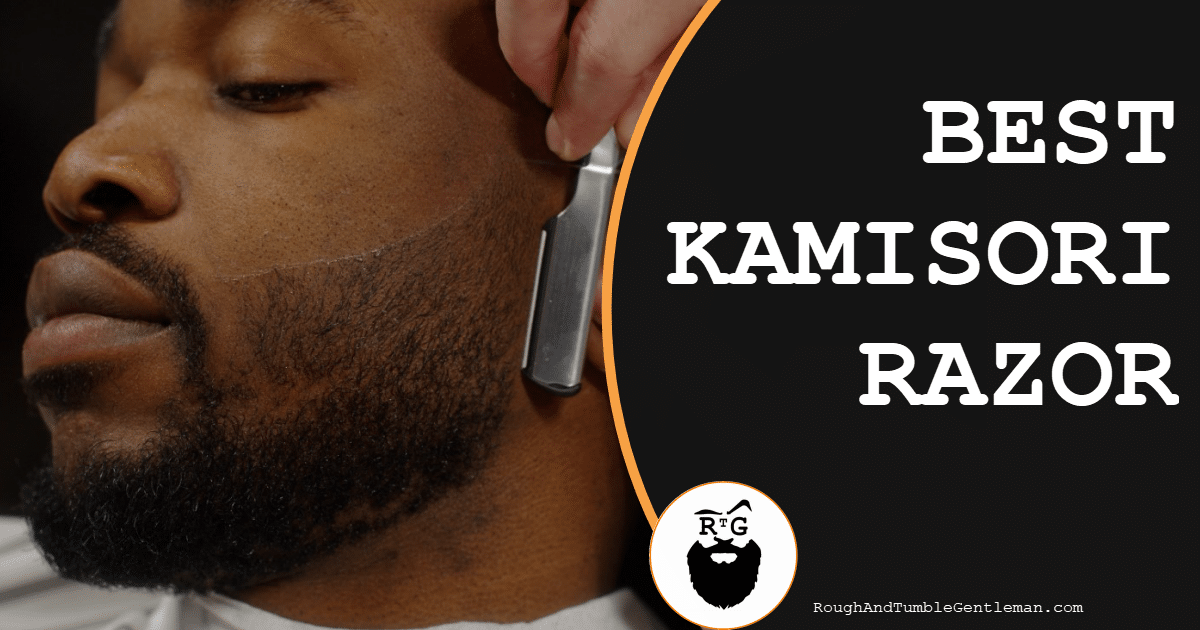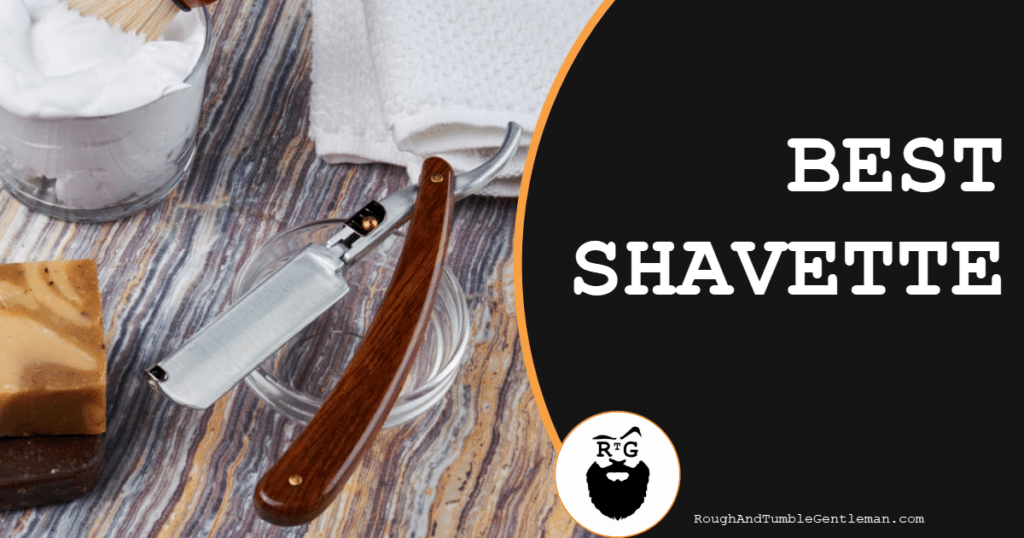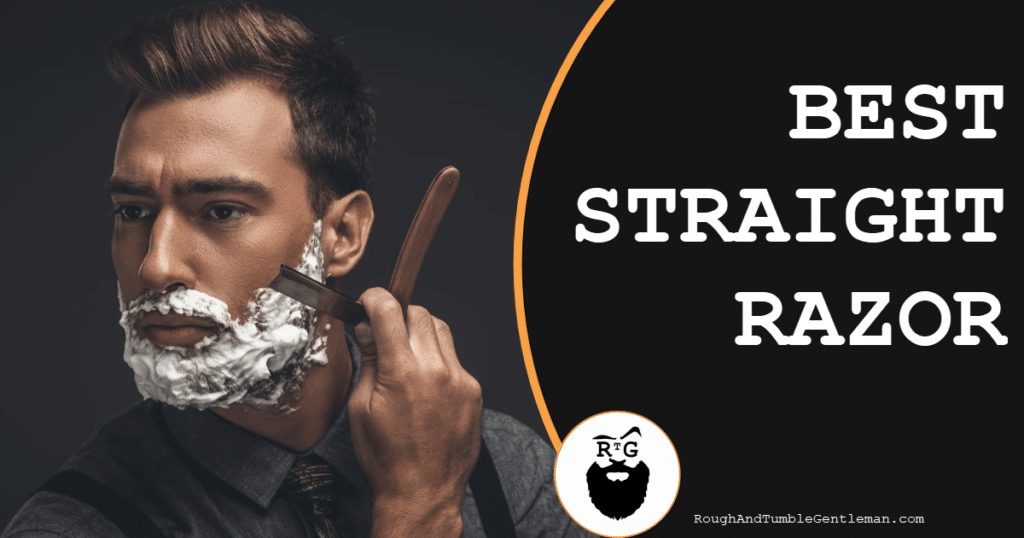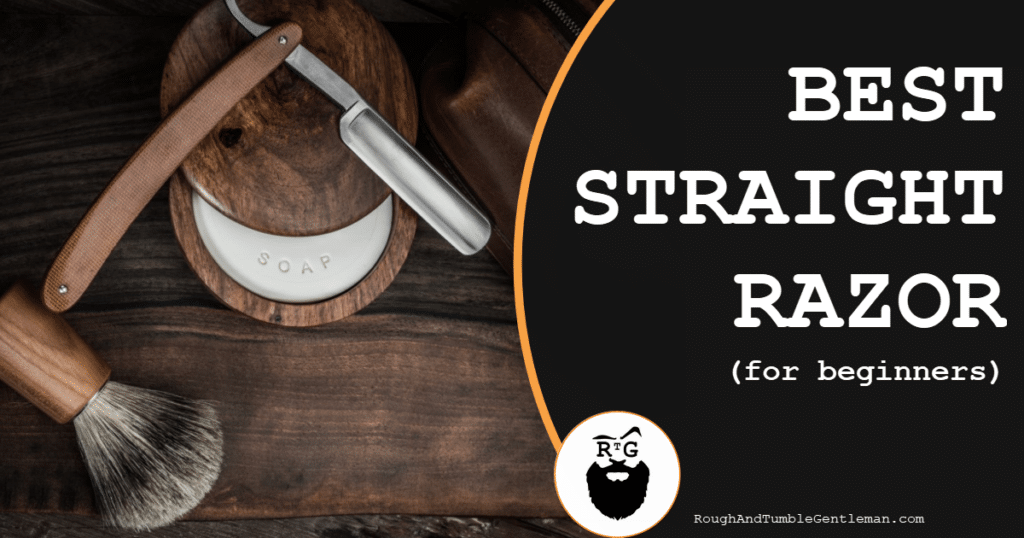Welcome! In this post, we’re going to discuss Japanese straight razors, aka, “kamisoris.” They’re fascinating blades, and we’ll look at the features that make them unique, their history, and what we believe to be the best Kamisori Japanese straight razor.
Let’s start at the beginning:
First of All—What is a Kamisori?
You’re probably familiar with Western-style straight razors. They feature a long, thin razor that folds into a handle made of wood or bone or metal, and they look something like this:

One of the most important features of Western straight razors is that they have a “symmetrical hollow grind.” That means, basically, that both sides of the knife blade taper inward toward the sharp edge of the blade. The following image shows the shape of a blade if you were looking straight at it—as if someone pointed the razor directly at you, and you were looking down its spine:

As you can see, there are different “grades” of hollowness. A 1/4 hollow blade will taper inward at a more gradual degree than a 1/2 hollow blade, and so on. On Western straight razors—the type you’d find in Europe, the United States, Canada, and so on—both sides of the blade taper inward at the same rate. They’re symmetrical.
Japanese straight razors—called “kamisoris”—are not symmetrical. They are hollow on one side of the blade, and on the other side, they resemble a side of the “true wedge” blade (that you can see in the image above, at the right). Here’s an example:

Image credit: KWie, via Wikimedia Commons
Sometimes the non-hollow side of a kamisori is totally flat, and other times it has a very slight hollow—but that structural difference is the main difference between Western straight razors and Japanese razors. The side with the hollow ground is referred to as the “omote,” and the side with the flat or partially ground hollow is called the “ura.” For centuries, Japanese men used the “omote” side to shave—and that’s definitely the more traditional way to use a kamisori—but in practice, many present-day users of kamisoris shave with both sides of the blade.
The other obvious difference is the handle. Traditional Western blades fold into the handle, effectively making them two-piece tools. Kamisoris, on the other hand, are a single and solitary piece of steel (and always steel), where the blade fades into the handle. The handle itself may be wrapped in bamboo, or rattan, which feels familiar to wicker, or it may even simply be steel with etching for a better grip. If Western straight razors are like switch-blades, kamisoris are little more like swords.
All of these factors add up to an entirely unique—and entirely different—shaving experience than you’d get with a Western straight razor.
Kamisoris: A Fascinating History
“Kamisori” is a very exotic-sounding word, but it’s actually a simple translation of the Japanese word for “blade.” Translations often provide insight into another culture, or illustrate a new way of thinking about the word being translated, but that’s not the case here. “Kamisori” just means “blade.” If that seems somewhat disappointing to you, fear not: the history of kamisori is far more fascinating, and involves religion, immigration, tradition, and good old-fashioned steel.
Kamisoris date back almost a millennia, when they were introduced to Japan by Buddhist monks who sailed to the mainland from the Korean peninsula. Hair removal is of great important to Buddhists, and it serves some very important purposes: not only does it follow the example of Gautama Siddhartha (the man who became the Buddha), when he left his magnificent palace, turned away from wealth, and began his search for enlightenment, but it’s also symbolic—it is an outward rejection of what Buddha calls “the three poisonous attitudes” of confusion, hostility, and attachment. By removing the hair on his or her head, the monk is making a statement to forsake these “mental toxins.” The kamisori was an important part of hair removal, and the monks brought the item to Japan when they emigrated from Goryeo Dynasty (which ruled what is now modern-day North and South Korea).
The Japanese did not initially adopt usage of the kamisori in any widespread way; it wasn’t until the widespread embrace of Bushido that tonsorial use of the kamisori became en vogue. Bushido is a kind of honor code, somewhat similar what Europeans would call chivalry—it was a discipline of loyalty to the noble classes, sincerity in all actions, and martial arts ability—and the Bushido code was a way of life for the samurai, who served as the warrior class of medieval Japan. The samurai adhered to strict grooming codes, and adopted use of the kamisori to rid their faces of hair. As often happens, modes of appearance work from nobility downward, and many in Japan mimicked the appearance the samurai, and also began to rid themselves of beards and facial hair.
The truly fascinating aspect of kamisori is that it remained in use, even as foreign blades entered the Japanese market. Germany—another culture with a very strong blade-making history—exported many straight razors to Japan, and while they were adopted, the kamisori maintained its popularity. In fact, not only did the unique design of the kamisori remain popular, it survived centuries of design advancements (and further influence from outside cultures), and is still very popular today.
Kamisoris: Pros and Cons
Most of our site’s visitors have some experience with Western-style razors, and after some usage, decide to venture into kamisoris. That makes sense—kamisoris are a little exotic, and if you live in the United States or Canada or the UK, you’re more likely to get into wet shaving using a traditional Western blade. They’re what most barbers use, and they’re usually what sites like this one focus on.
That said, a *lot* of wet shavers end up interested in kamisoris. They’re somehow very similar and very different at the same time, and that has a draw for a lot of men.
If that describes you, here are some “pros” and “cons” you may want to consider (and, keep in mind, these are some of the features we consider when reviewing our picks for the best Japanese straight razor, below).
Pros of Japanese Straight Razors
It’s a New Challenge. We know a lot of wet shavers, and we hear this again and again: “I wish I could learn something new.” Wet shaving is a skill, and a lot of guys truly love the practice, and once they’ve mastered it, there’s that weird let-down of not having any more shaving-related challenges. As Hans Gruber said in Die Hard, “And Alexander wept, for there were no more worlds to conquer” (or something like that).
Here’s the good news: kamisoris are most definitely a new challenge. You will be able to use the skill you developed with a Western-style straight razor, but it’s tricky—especially if you’re going to go the traditional route, and use only the “omote” side to shave. If you’ve grown a little tired of your regular shave and want a challenge, they can be a good option.
Keep in mind, it’s not a great option if you’re new to wet-shaving—for that we’d point you to our list of recommended “beginner” straight razors—but if you’re familiar with straight-razor shaving and looking for a novel challenge, these can be a fun adventure.
There’s Something Uniquely Fascinating About Them. We’re going to save all this for a later section, where were can really discuss things, but we’ll briefly list it here: kamisoris are pretty fascinating, and they’re easy to romanticize. More on that in a minute.
They Can Last for a Very, Very Long Time. Western straight razors are obviously pretty long-lasting, as well, but because kamisoris are basically super-sharp chucks of steel and nothing else, they’ll last as long as you can keep them sharp. Western razors may eventually have problems with the handle (a rusty pivot, for example), and may need to be replaced over time. With proper care, the potential for a kamisori to last a very long time is very, very high.
Cons of Japanese Straight Razors
They Have a Shorter Blade Length. This doesn’t seem like that dramatic of a difference, but in practice, it can be. It’s another unique feature of the kamisori that becomes a challenge. We’ll list this in the “Con” section instead of the “Pro” section because some guys (but not all, obviously) dislike that discrepancy. It leaves a little less margin for error, and that can be frustrating, because…
There’s a Learning Curve. In other words, it’s very likely you’re going to get nicked a lot. One shaver described his kamisori as “blood-thirsty,” and that’s a fairly terrifying description.
As we mentioned, the omote and the ura are a challenge, but there’s another hurdle: spike points. The blade of a kamisori has two ends, and those two ends of the blade are at a right angle, or pretty close to it, and they’re called spike points. And, brother, take it from us: spike points at the end of a kamisori blade are sharp. If you’re not paying attention or being careful, you’re going to end up in nick city. Some guys “mute” them, meaning they round them down a little bit—and that’s always an option. It’s one that we advise you avoid—muting spikes is a defacement of the blade, really, and you can never get those points back—but “to each his own,” as they say. If you don’t like the points, you can get rid of them.
At any rate, spike points are a feature of kamisoris, and they’re something you’ll want to keep in mind.
They’re Tricky to Hone. Because they are structurally different that Western straight razors, they need to be sharpened differently, and that, too, can take some getting used to. In fact, because they’re so different, many guys who get kamisoris have them professionally sharpened (and here’s a place where that service is offered).
They’re Hard to Find. There are far more manufacturers of Western-style straight razors than there are manufacturers of kamisoris, especially on this side of the globe. While they have, in fact, experienced a decent resurgence in popularity, they’re still a bit of a rarity. There are artisans who make them, but those are works of art—and they can be difficult to find.
And that’s a great segue!
Kamisori Reviews
There are two models that get our vote for “Best Japanese Straight Razor.” They are:
The Traditional Bamboo-Wrapped Japanese Straight Razor
The Traditional Bamboo-Wrapper Straight Razor is a true kamisori razor, made from high-carbon steel, and manufactured in Japan. It’s a beautiful model, and it’s got exactly the dimensions we’d hope to find in a kamisori:
It’s roughly six inches long, which—if you’re used to shaving with traditional Western razors, may feel a little bit small, but it’s right in the range of traditional Japanese razors. It’s got an extended toe that extends past the head, giving an aggressive, pointed look; and
It features a blade that’s roughly two inches, and that, too, is right in the neighborhood of a traditional kamisori. The blade itself has potential for incredible sharpness (although it may need to be sharpened upon arrival), and—remember above, when we discussed how sharp spikes can be? This is exactly what we were talking about. The spikes on the Traditional Straight Razor are sharp, sharp, sharp. That’s a good thing, ultimately—once you learn how to use those spokes, they’re great for edging sideburns and doing detail work in hard-to-reach areas, like under the nose—but it’s definitely something to keep in mind. You don’t want to forget about those! and finally
It’s got a squar-ish end of that end of the handle, wrapped in Banshu fabric.
This is a bright, sharp, and minimalist kamisori, and we think it’s an absolutely gorgeous model.
Feather SS Japanese Straight Razor
The Feather SS Japanese Straight Razor is another beautiful model. It’s not an official kamisori—it uses replacement blades, instead of featuring a permanent, immovable blade—but in our opinion, it’s still a Japanese straight razor par excellence.
This is a “best of both worlds”-type model—it has the non-folding handle and the small, concentrated razor edge, and in our experience, it’s a little bit easier to use than a traditional kamisori. While replacement blades aren’t exactly traditional, they sure make things easier—rather than having to hone and re-hone a blade, you simply grab a new blade when you need one (and replacement blades usually get four or five uses), and you’re good to go.
If you’re looking to make the switch from Western-style straights to kamisoris, this might be a good option—you can get used to shaving with a non-folding handle, while learning how to get an effective shave with a smaller blade edge (and also learning how to navigate those spikes).
Finally, if you like the Feather SS but you’re looking for similar model that’s got a splash of color, there’s the Feather SS Japanese Straight Razor in Lime, that’s very similar, but manufactured in a pleasing lime color. Traditional and funky—nice.
Closing Thoughts on Kamisoris
Grooming—and in particular, male hair removal—has been practiced for millennia, by every culture, at every spot on the globe. At that’s what makes Japanese straight razors so fascinating: how different cultures come up with different versions of the same tool to achieve an end. Western-style razors and Japanese straight razors are both designed to separate whisker from face, but all of the wonderful little details about both types of razors are so incredibly different.
Compared to their rugged Western counterparts, kamisoris are simple, and elegant—in an age where the fanciest, flashiest, brightest thing gets your attention, it’s comforting—and invigorating—to think of something so simple and so powerful.
We hope you enjoyed the post. If you decide to incorporate a kamisori, or any kind of Japanese straight razor, into your shaving routine, we wish you all the best! Enjoy, and happy shaving!
Michael Morris is the head writer here at Rough and Tumble Gentleman. He's got a ducktail beard and loves Brazilian jiu-jitsu. He's married to the woman of his dreams and lives in Brooklyn, NY.




